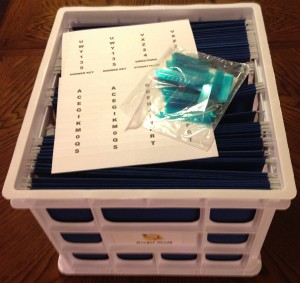Question: What is the purpose of this writing speed test exactly? Should a child be held back from progressing through the levels simply because they have not passed the writing speed test, especially when they already know their math facts? Can you please clarify?
Answer: The purpose of the writing speed test is to make sure that students are not asked to write answers to math facts at a rate faster than they are able to write. The purpose is not to hold children back who know the facts—exactly the opposite. The test is to make sure their goals are appropriate and that they are not held back by their writing speed.
There is also an explanation under Letter “i” in our FAQs. It is also covered in the complete Teachers Directions–free to download. Not all teachers have these directions—so feel free to share them.
What about students who can’t write the answers to 40 problems per minute? (This is a great question. We are very very impressed and glad you asked!)
For less than fluent writers their goal is to write as many answers as they can write in one minute. See the information about the Writing Speed Test for details of how their goal would be adjusted down from 40 problems per minute. Their goal will be to answer as fast as their little fingers can write! We do not want children to be hesitant, or have to stop to figure out math facts. We want them automatic, with as little thought required as possible. We definitely do not want them counting on their fingers. Allow us to repeat ourselves here… NO FINGER COUNTING!
Why do I have to give a writing speed test?
We have found that many children are not able to write the answers to 40 problems in one minute. They can orally say the answers to that many problems, but they can’t write that fast. In grades one and two it may be nothing more than an “inexperienced little hands” problem. In other grades handwriting speed is dependent on other variables.
When they learn their facts, but cannot pass a test, due to slow writing, we see much weeping, gnashing of teeth and pulling of hair. (And that’s just the teacher.) Suffice it to say, it’s not a pretty sight. So we want to establish goals for all students that are no faster than they can write. To do that we have to find out how fast they can write. That’s why we have to give the Writing Speed Test.
How do I give the Writing Speed Test?
The Writing Speed Test is pictured above. The children are going to write in each box the number they see up in the corner of the box. They look at the number and write it. That’s just how fast they should be with the math facts—just look at the fact and write the answer without hesitation. However many boxes they can write the numbers for in one minute, determines the number of problems they can be expected to write the answers for in one minute. This sets their goal.
When you give the test, make sure all students are situated with their papers out, names on them and their pencil at the ready. Tell students to hold their pencil up (yes, in the air!) when they are ready. [This is a really cool technique to use for all timings. If students are holding their pencils at the ready and in the air, nobody can be cheating by starting early. Also, in this way you can look out over the masses and easily tell when everyone is set and ready to go.] The directions for the Writing Speed Test are on the test sheet. Read these aloud. Do not allow any students to start ahead of time as this will invalidate their score. Have the students write in the boxes as fast as they can for one minute. Then they can put the tests back into their folders, and turn in their folders. You will be taking the information from the test and putting it onto the goal sheet.








